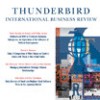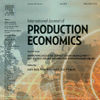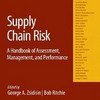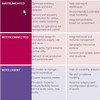T he year 2007 will be remembered as the year the toy industry was shaken by a seemingly endless stream of recalls. Can we learn something from the 2007 toy recall crisis? Is China really to blame, or are the drivers and causes of this crisis originating from much closer to home? Yes it is, says Mary B Teagarden, Professor of Global Strategy at the Thunderbird School of Global Management, in her 2009 article Learning from Toys: Reflections on the 2007 Recall Crisis, where she contends that much of blame lies with (American) businesses themselves. Much of the focus has been on China and its contractors, but China is not solely to blame, as many of the risk drivers come from the companies who outsourced the production, not the Chinese manufacturers.
he year 2007 will be remembered as the year the toy industry was shaken by a seemingly endless stream of recalls. Can we learn something from the 2007 toy recall crisis? Is China really to blame, or are the drivers and causes of this crisis originating from much closer to home? Yes it is, says Mary B Teagarden, Professor of Global Strategy at the Thunderbird School of Global Management, in her 2009 article Learning from Toys: Reflections on the 2007 Recall Crisis, where she contends that much of blame lies with (American) businesses themselves. Much of the focus has been on China and its contractors, but China is not solely to blame, as many of the risk drivers come from the companies who outsourced the production, not the Chinese manufacturers.
Learning from toys – part 2
Interestingly, a paper which I have reviewed on this blog previously, and which was written by M. Eric Johnson in 2001, is not mentioned by Teagarden in her references, albeit she uses the same line in her title: Learning from Toys: Lessons in Managing supply Chain Risk from the Toy Industry. Here, the toy industry is used as a showcase example for how supply chain risks could and should be managed. Product recalls do not feature in Johnson’s article; it is all about matching supply and demand and running the supply chain as cost-efficient as possible. Outsourcing keeps operating costs down, which leaves more money for brand building and advertising.
It’s not China’s fault
Teagarden contends that the reason for why things went wrong lies with us:
Instead of simply blaming China, we must take a hard look at American issues, those that we can control, that contribute to this problem. In so doing, we will see that we are a big part of this problem. American big box retailers and their unrelenting pressure on suppliers for ever-lower prices bear part of the responsibility. American importers focusing on cost and investing in brand rather than quality and supply chain integrity bear part of the responsibility. Parents who want low-priced toys in response to their children’s requests for the latest television-advertised toy bear part of the responsibility. Finally, the American government’s choce to chronically underfund watchdog agencies like the Consumer Product safety Commission is part of the problem.
This may sound harsh, perhaps, but true, part of the responsibility does belong to ourselves. Moreover, you could just as well replace “American” with “European” or any other country.
Five lessons
We do not control China. China controls China, Teagarden says. Although we can do whatever we can to influence China, we must also do our best to manage our share of the problem. Teagarden points to five lessons that can be learned from the toy recall crisis:
- Corporate social responsibility is a delicate balancing act
- Size matters
- Distance matters
- Supply chain development is critical in offshore manufacturing
- Trust not, verify all
The first lesson points to the adage of he who talks the talk, must also walk the walk. Words must be followed by actions, actions that ensure full supply chain integrity, end to end. This takes us to the second point.
If you want to walk the talk, size matters. Simply put, the bigger you are, the more you can squeeze your supplier. And it is not about squeezing costs, that would be counter-productive, because the squeeze is simply passed on to the next tier in the chain, until one tier has no choice but to compromise on the requirements in order to make his profit.
That is the third point, distance matters, elegantly captured in the Chinese proverb of “The mountains are high and the emperor is far away”. Not only geographical distance, cultural distance, too, plays in important role here.
This ties up with the fourth lesson, supplier development, where a company must invest time and effort in developing not only standards and principles on paper, but must invest in building skills and abilities in the supplier network.
The final point, verification, is the culmination of the four previous lessons: supply chain vigilance, meaning that you can only trust so much, in order to be 100% sure you must verify, at all levels.
Conclusion
I find this a very thought-provoking article. Whichever way you put, it is not so much China who owns the tainted product problem. We do ourselves. China is just doing what we tell them to do (or rather, what we do not tell them not to do).
Reference
Teagarden, M., & Hinrichs, M. (2009). Learning from toys: Reflections on the 2007 recall crisis Thunderbird International Business Review, 51 (1), 5-17 DOI: 10.1002/tie.20229
Author link
- thunderbird.edu: Mary B. Teagarden
Related posts
- husdal.com: Can you outsource risk?
- husdal.com: Outsourcing – risking it all?
- husdal.com: Learning from toys












